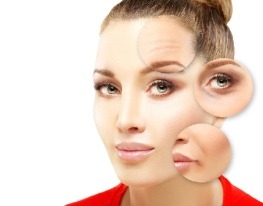About Us


Wrinkles, frowns and lines are
the result of pulling or gathering
of muscles to create a fold.
Botox
Wrinkles, frowns and lines are the result of pulling or gathering of muscles to create a fold. The wrinkles and furrows are caused by the effect of gravity as well as the repeated action of underlying muscles associated with facial expression. Years of squinting and furrowing tend to leave deep wrinkles in the skin at the corner of the eyes, between the eyebrows, on the bridge of the nose and on the forehead.
These lines can make the face appear angry, tired, sad or dull. Correcting these lines can restore the natural pleasant appearance of the face. A pleasant and relaxed looking face with softer expressions lends to a refreshed and youthful appearance. Cosmetic Dermatologists and Dermatosurgeons can now remedy these wrinkles and lines by a simple injection of botulinum toxin. This procedure and the injectable used is US FDA approved, and is suitable in patients of all skin types and skin color.
Botulinum toxin has been used by doctors of various specialities (dermatologists, ophthalmologists, neurologists, orthopedic surgeons etc.) for treating various muscle and nerve related ailments, since the 1980s. It is a purified substance derived from a bacteria. The toxin acts by blocking the signals and impulses sent from a nerve to the muscle. It is injected into muscles that are too tight, in order to relax that muscle.
Hence, these injections only work on wrinkles that are produced by facial expressions like smiling, frowning or pouting. Such wrinkles are called ‘wrinkles at motion’, and they start appearing in the late 20s and do not become fixed on the face by one’s mid-50s.
Botulinum toxin cannot work on wrinkles and lines which are ‘fixed’ or seen permanently on the face, even when the face is relaxed and without expression. Such wrinkles are called ‘wrinkles at rest’ and they appear from one’s late-50s and remain on the face permanently. These lines and wrinkles can be ‘filled out’ with soft tissues fillers or the entire area of the face can be tightened with surgical or non- surgical facelifts.
Your dermatologist will first take a detailed history, including medical and surgical ailments, allergies, medications used etc. This is followed by a physical assessment and categorization of the wrinkles, including photography.
You will be questioned on your expectations from the treatment and the ‘problem areas’ as perceived by you. You will then be given some patient information literature (as this) for your education. We prefer not to inject a new patient at the first consultation. We prefer to give them time to read and understand the literature, and do the injections at the second consultation. The actual treatment is well- tolerated and takes just a few minutes with no “down time” and without prolonged recovery time.
Botulinum toxin takes effect about 3 to 7 days after treatment. So the ‘After’ pictures will only be taken a week later. At this point, you may require a few additional injections as a ‘touch-up’ if your dermatologist so decides. The improvement generally lasts about 3 to 6 months, before the effect gradually fades and muscle action returns.
It is anticipated that an average patient will require reinjection at various intervals. It varies from patient to patient, depending upon the bulk of the muscle, how often you use the muscle and your metabolism. With repeated treatments, the muscle gets thinner in bulk from decreased usage. This phenomena produces long lasting results.
Botulinum toxin is used to treat the lines between the eyebrows and on the bridge of the nose. It is used to treat crows feet and forehead lines as well. We also use it to create a brow lift, to lift downturned lips and to give a more wide- eyed look ( eg, in Oriental men and women ).
Most Indian dermatologists only use Botulinum toxin to treat lines and furrows in the upper half of the face. In our facility, we also specialize in treating the problems of the lower half of the face. This includes neck lines, correcting gummy smiles, and to slim down a broad face or tighten loose skin around the chin and jaw line (the ‘Nefertiti face lift’). Highly diluted botox is used to treat fine lines of the face, to give an overall skin smoothening and tightening affect. Most patients do not want dramatic changes and prefer to retain some lines while relaxing the deeper wrinkles. Some patients prefer a mask-like or porcelain look, especially over the forehead.
Your dermatologist can vary the dosage of injection, as per your specifications. Other muscles like those needed to smile or to raise the eyebrows, are not affected, so a natural expression is maintained. Botulinum toxin is less useful for the smile lines around the mouth because the muscle action in this area is needed for important functions like eating and talking. These lines can be corrected by injecting soft tissue fillers. Both procedures can be carried out in the same session. Botulinum toxin may be used in combination with other cosmetic skin procedures like chemical peels, fillers and laser tightening or resurfacing, in order to address various skin changes related to ageing, and to optimize results.
Side effects are minimal and typically relate to the injection site. Soreness and mild bruising, while uncommon, may occur around the injection site. Make up can be used to cover a shiner. Avoid painkillers and green tea for a few days before and after the procedure, as they increase the tendency to bruise. The bruise will fade away in a few days. Do not press or massage the area (eg, facials, sauna etc.) for several hours. Stay upright and avoid running/exercises for at least 4 hours. This is to avoid diffusion of the toxin into the neighboring muscles.
Some may experience a temporary headache after injections in to the forehead area. In rare instances, patients may experience slight drooping of the brow or eyelid. These side-effects are temporary and do not occur with experienced practitioners. Asymmetrical results can be easily corrected during the ‘touch- up’ session. All the possible side effects are mild and temporary, and cause no significant limitation in routine activities. This procedure cannot be performed in pregnant or nursing women. This procedure is also avoided among those with certain neurological ailments.
